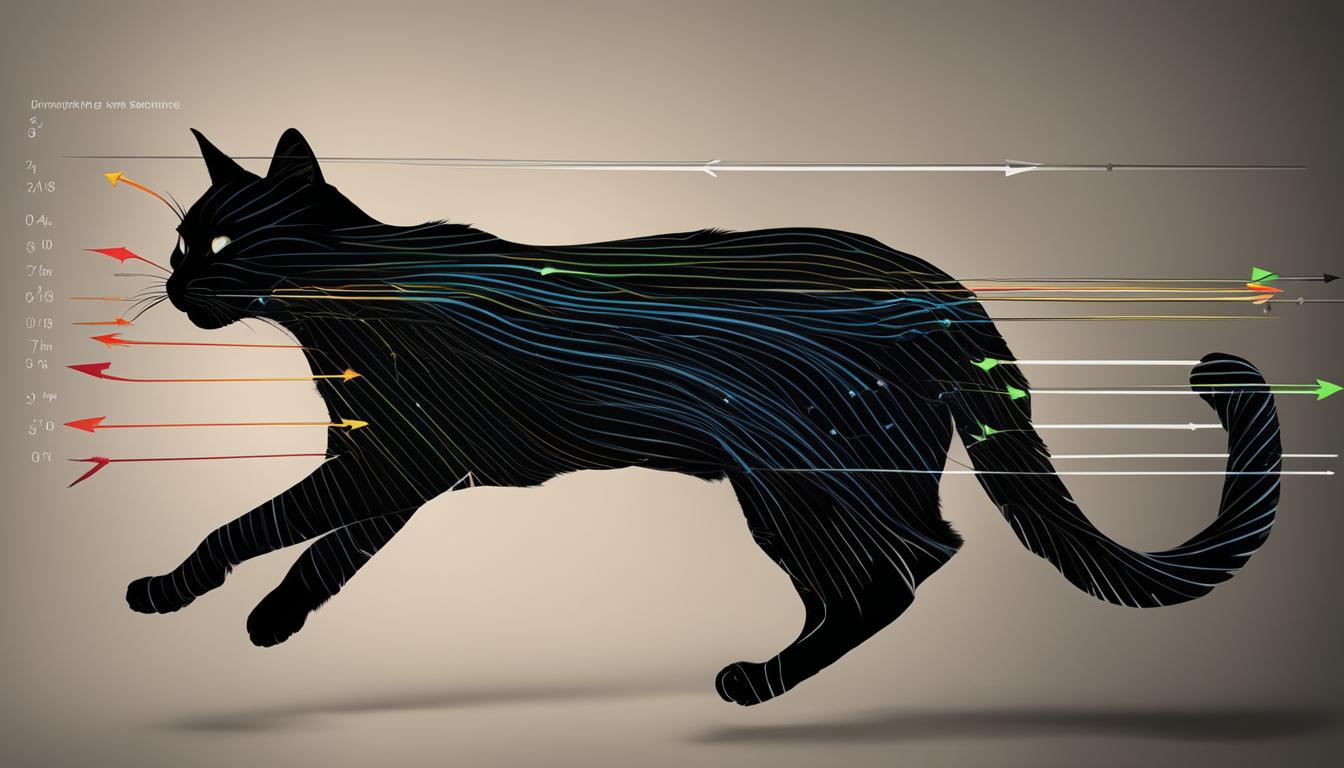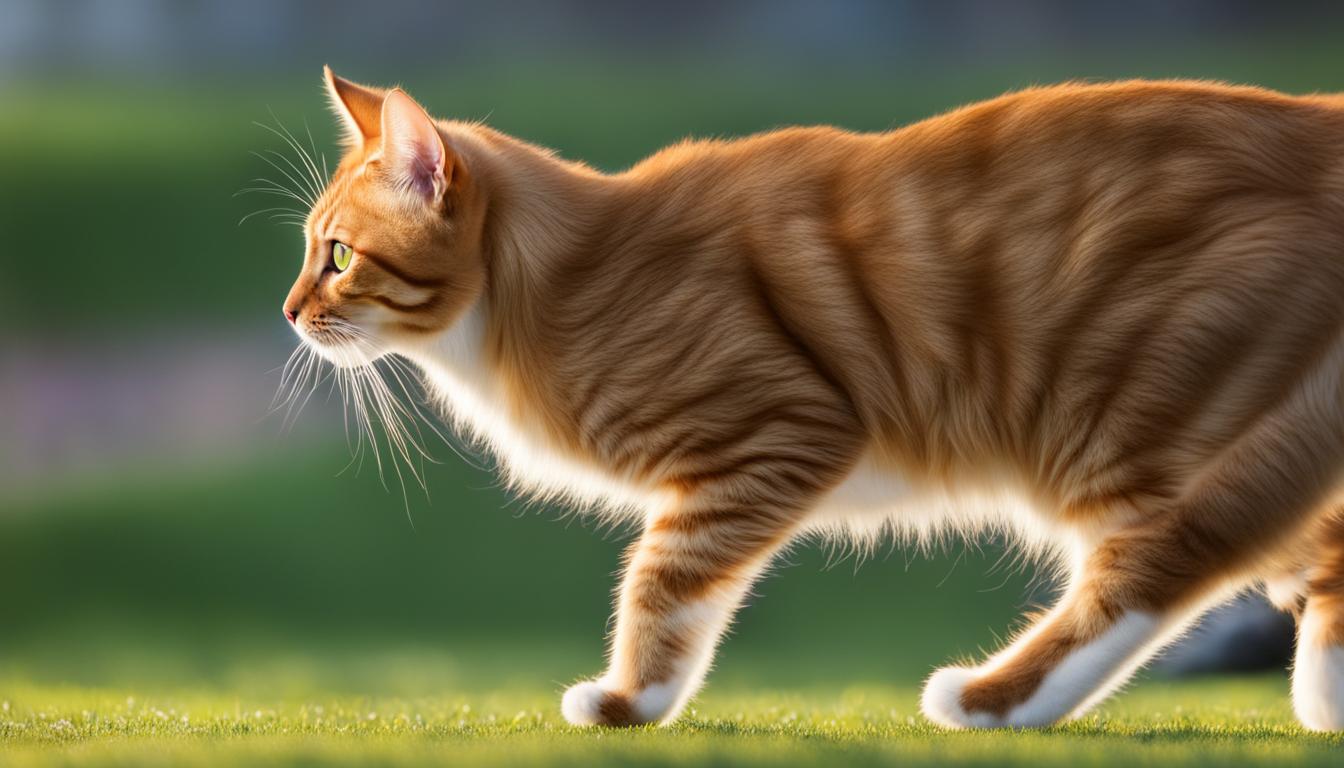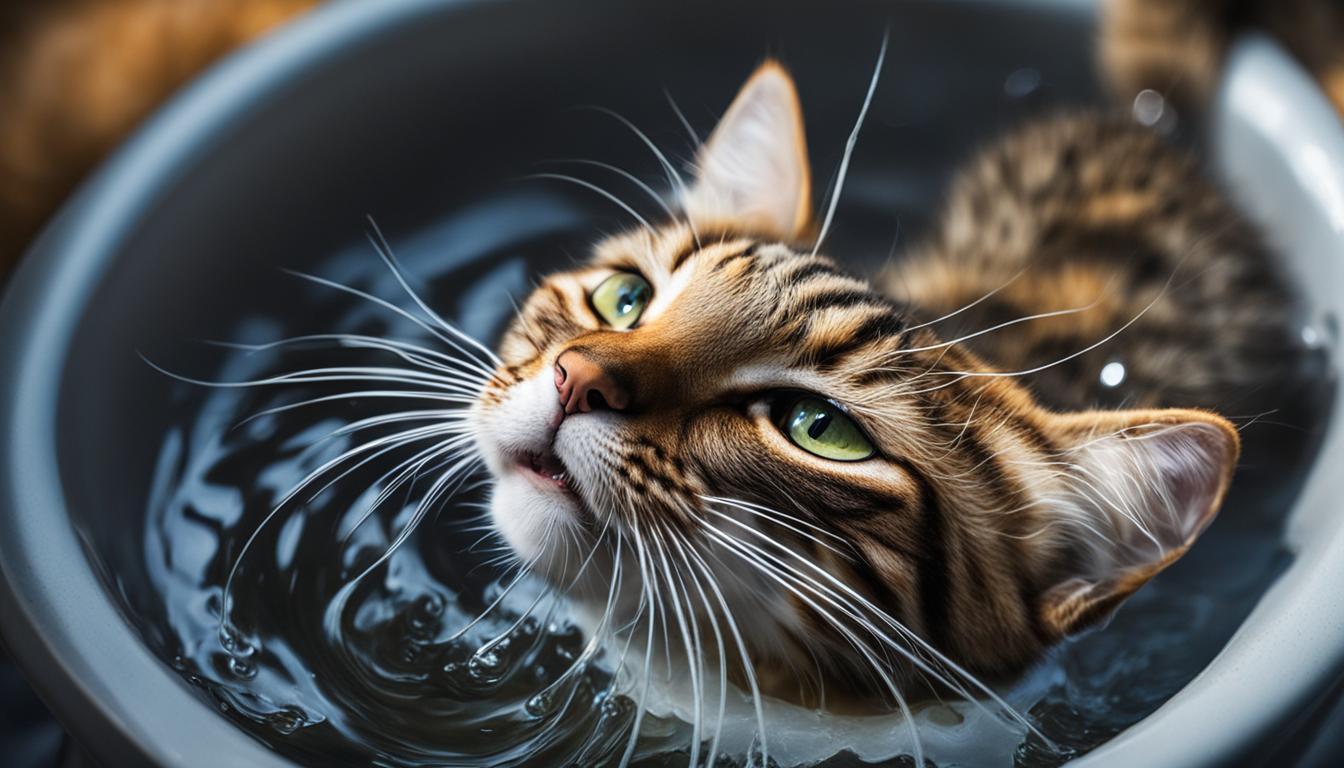Have you ever marveled at a cat’s ability to effortlessly leap to great heights? It’s truly fascinating how these furry creatures defy gravity with their impressive jumps. Today, I’m going to take you on a journey into the physics behind a cat’s jump and explore just how high they can go. So, let’s dive in and unravel the secrets of their extraordinary athleticism!
Key Takeaways:
- Cats can jump up to six times their body height and reach heights of over five feet.
- Their jumping abilities are primarily influenced by the strength and power of their muscles.
- Cats have a high proportion of fast-twitch muscles, flexible spines, and shorter, lighter bones that contribute to their leaping prowess.
- Factors such as breed, age, weight, and health can affect a cat’s jumping capability.
- Understanding the physics behind a cat’s jump helps us appreciate their remarkable agility and athleticism.
The Physiology Behind a Cat’s Incredible Jumping Ability
Cats are known for their impressive jumping abilities, but have you ever wondered how they can leap such great heights? The secret lies in their unique physiology, which has evolved to give them some of the strongest jumping capabilities in the animal kingdom.
Cats have more than 500 muscles in their body, and they utilize these numerous muscles when they jump. What sets them apart is their exceptionally high proportion of fast-twitch muscles compared to other animals. These fast-twitch muscles provide cats with greater explosive power, allowing them to generate the force necessary to propel themselves into the air.
But it’s not just their muscles that contribute to their remarkable jumping abilities. Cats also have flexible spines and shorter, lighter bones, which enable them to extend far beyond their normal range of motion when they jump. These structural adaptations minimize strain on their bodies and maximize the height they can achieve. Additionally, cats’ specialized tendons, such as the Achilles tendon, provide extra flexibility and help cushion the impact on their legs when landing from extreme heights and distances.
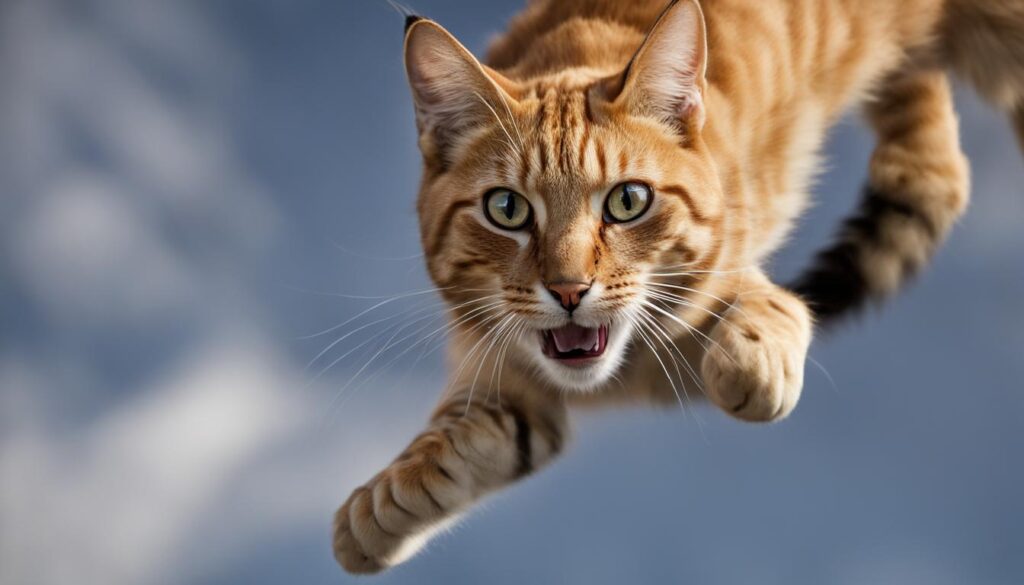
As the cat rises in the air, it tucks its back legs under its body and stretches out its front legs. This adjustment in posture ensures a safe landing and helps the cat maintain balance during the jump. Cats also utilize the spring-like action of their tendons to maximize upward momentum, while the muscles in their legs provide the necessary force to propel them into the air.
“A cat’s leap is a perfect combination of power, precision, and grace.”
In addition to their physical abilities, cats possess remarkable coordination, balance, and a keen sense of proprioception. This enables them to make course corrections mid-jump and control their movements in midair, ensuring they land safely and accurately on their target.
Jump training for cats
Jump training can be both a fun and beneficial activity for cats. It helps them develop their muscles, increase coordination, and improve their overall physical fitness. Here are a few techniques for jump training in cats:
- Use positive reinforcement: Reward your cat with treats, praise, or playtime when they successfully complete a jump. This positive reinforcement encourages them to continue practicing and improves their motivation.
- Start low and gradually increase height: Begin jump training with lower surfaces, such as chairs or low tables, and gradually raise the height as your cat becomes more comfortable and confident in their jumps.
- Use toys or treats as targets: Place a toy or treat on a higher surface to entice your cat to jump and reach for it. This helps them focus on a specific target and provides them with a clear goal to achieve.
- Provide ample resting time: Cats require plenty of rest between training sessions to avoid exhaustion or overexertion. Allow your cat to rest and recover before engaging in further jump training activities.
Remember, jump training should always be conducted in a safe environment, free from obstacles or potential hazards. And most importantly, make sure to have fun and enjoy the process of training and bonding with your furry friend!
Can all cats jump high?
Cats are renowned for their incredible jumping abilities, but can all cats jump high? While cats in general possess impressive leaping skills, there are factors that can influence their jumping capabilities, such as breed, age, weight, and health.
Table: Comparative Jumping Heights of Different Cat Breeds
| Breed | Jumping Height (in feet) |
|---|---|
| Abyssinian | 5.5 |
| Savannah | 6.5 |
| Maine Coon | 4.5 |
| Persian | 3.5 |
| Siamese | 4 |
The table above showcases the jumping heights of different cat breeds. Lean and muscular breeds such as the Abyssinian and Savannah tend to be better jumpers, reaching heights of 5.5 and 6.5 feet respectively. On the other hand, breeds like the Persian and Siamese have slightly lower jumping heights of 3.5 and 4 feet. It’s important to note that these heights are general averages and individual variations may occur.
Quote: “Wild cat species, such as the serval or the ocelot, are typically better jumpers than domestic cats due to their longer legs and more powerful muscles.”
While all cats have inherent jumping abilities, certain wild cat species, like the serval or ocelot, are typically better jumpers due to their longer legs and more powerful muscles. These wild cats can achieve even greater heights than their domestic counterparts.
However, it’s not just genetics that determine a cat’s jumping abilities. Age can also play a role, as older cats may experience joint stiffness or arthritis that hinders their mobility and reduces their jumping height. Additionally, weight and overall health can impact a cat’s jumping capability. Overweight cats may struggle to lift their bodies off the ground, resulting in a limited jumping range.
So, while cats in general have impressive jumping capabilities, the specific heights they can achieve can vary depending on various factors. Nevertheless, their natural agility and athleticism never cease to amaze us.
The role of a cat’s hind legs
When it comes to a cat’s impressive jumping ability, their hind legs play a crucial role. These legs are not only stronger and longer compared to their front legs, but they also provide the main propulsion for their jumps. Cats possess powerful muscles in their hind legs that generate the force needed to propel them into the air.
As a cat prepares to jump, it crouches down and gathers energy in its muscles. When it’s ready, it rapidly extends its hind legs, using the strength and power in those muscles to launch itself into the air. The hind legs’ angled position enables better shock absorption upon landing, protecting the cat’s body from impact-related injuries.
Furthermore, cats extend their front legs as soon as their hind legs propel them forward, providing stability and helping them grasp landing surfaces. This coordinated movement ensures a smooth and controlled landing. The hind legs’ muscles and tendons also contribute to the cat’s incredible springiness, allowing them to achieve impressive heights and distances in their jumps.
Techniques cats use to leap
When observing a cat’s leap, several techniques come into play. Cats rely on the spring-like action of their tendons to maximize their upward momentum, while the muscles in their legs generate the necessary force for propelling them into the air. Their coordination, balance, and sense of proprioception enable them to make mid-jump adjustments and precisely control their movements while airborne. These remarkable feline abilities showcase their agility and athleticism in action.
Overall, the unique muscle anatomy of jumping cats, combined with their specialized techniques, allows them to execute impressive leaps and bounds. Understanding the role of a cat’s hind legs and the techniques they employ gives us a glimpse into the remarkable physics behind their extraordinary jumping abilities.
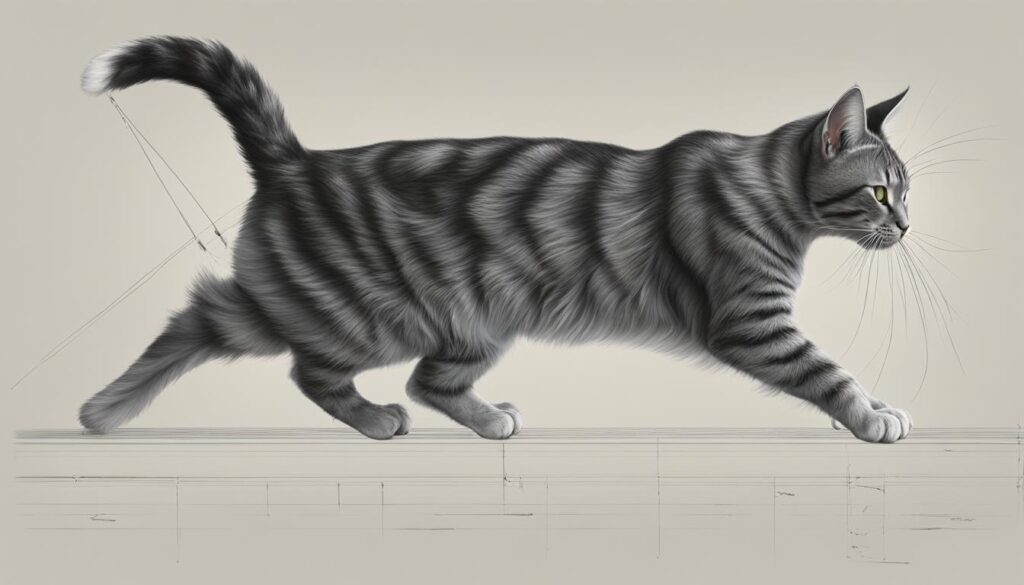
| Hind Legs | Front Legs | |
|---|---|---|
| Strength | Strong and powerful muscles | Muscles provide stability and grip landing surfaces |
| Propulsion | Main propulsion for jumps | Assist with stability and landing |
| Shock Absorption | Angled position for better shock absorption upon landing | N/A |
| Springiness | Muscles and tendons add extra power and springiness | N/A |
Factors Affecting a Cat’s Jump
When it comes to a cat’s jumping ability, several factors can influence how high and far they can leap. These factors include breed, age, weight, and overall health. Let’s explore each of these factors in more detail:
Breed
Certain cat breeds are known for their exceptional jumping abilities. Lean and muscular breeds like the Abyssinian and the Savannah are particularly renowned for their impressive leaps. These breeds have been selectively bred for their athleticism, giving them an advantage in terms of their jumping prowess.
Age
Age can also play a role in a cat’s jumping ability. As cats get older, they may experience joint stiffness or arthritis, which can affect their mobility and jumping capabilities. It’s not uncommon to see older cats struggling to lift their bodies off the ground or reach the same heights they once did.
Weight and Health
A cat’s weight and overall health can also impact their jumping prowess. Cats that are overweight may find it more challenging to propel themselves into the air due to the extra weight they have to carry. Additionally, cats in good overall health are likely to have better muscle tone and flexibility, allowing them to achieve greater heights in their jumps.
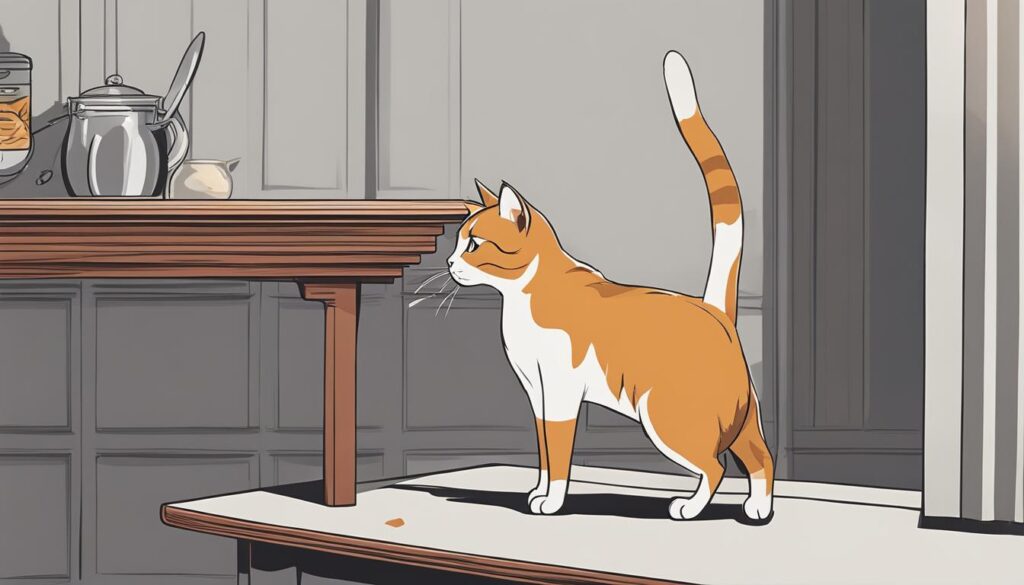
Understanding these factors can help cat owners better assess their pet’s jumping capabilities and provide the necessary care and support. Whether it’s keeping an older cat comfortable, maintaining a healthy weight through proper nutrition and exercise, or simply admiring the incredible athleticism of certain breeds, there is much to learn from the factors that influence a cat’s jump.
Conclusion
After exploring the fascinating physics behind a cat’s jump, it’s clear that these agile felines possess some truly remarkable abilities. From their powerful muscles to their flexible spines and specialized tendons, cats have evolved to become expert leapers. Their explosive power and coordination allow them to soar to impressive heights, reaching heights that many other animals can only dream of.
When comparing cat jumps to other animals, it’s evident that cats are among the best jumpers in the animal kingdom. While some wild cat species may have an advantage due to their longer legs and more powerful muscles, many domestic cat breeds have been selectively bred for their exceptional jumping prowess. Regardless of their breed, cats’ ability to control their movements mid-jump and make course corrections sets them apart from other species.
Understanding the physics of a cat’s jump not only gives us insight into their incredible agility, but it also helps us appreciate the adaptations that have developed over time. These adaptations provide cats with advantages in escaping predators, hunting prey, and navigating their environment. However, it’s important to remember that factors such as breed, age, weight, and health can influence a cat’s jumping capability.
So, the next time you observe a cat gracefully leaping to great heights, take a moment to marvel at the incredible physics behind their jump. Cats truly are extraordinary creatures, and their jumping abilities are just one of the many reasons why we find them so captivating.
FAQ
How high can cats jump?
Cats can jump up to six times their body height in one bound and reach heights of over five feet.
What factors affect a cat’s jumping ability?
Factors such as breed, age, weight, and health can influence a cat’s jumping capability.
Are all cats equally good at jumping?
Wild cat species tend to be better jumpers than domestic cats due to their longer legs and more powerful muscles. However, domestic cat breeds, especially those in the “oriental” group, have been selectively bred for their jumping ability.
Do hind legs play a crucial role in a cat’s jump?
Yes, a cat’s hind legs provide the main propulsion for their jumps and are angled to help with shock absorption during landing.
Can age affect a cat’s jumping ability?
Yes, older cats may experience joint stiffness or arthritis that can hinder their mobility and jumping ability.
How do cats adjust their posture during a jump?
Cats tuck their back legs under their body and stretch out their front legs to adjust their posture mid-jump for a safe landing.

